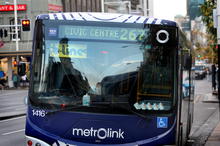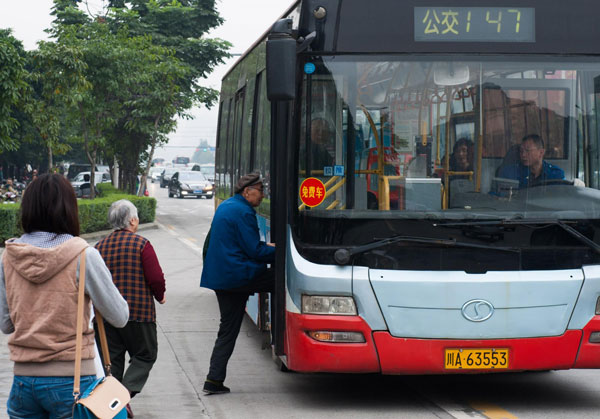What Really Happens When a City Makes Its Transit System Free?

When Jean-Francois Mayet became mayor of Châteauroux in 2001, the
town’s transit system was descending into irrelevance. Each of
Châteauroux’s 49,000 inhabitants took the bus, on average, 21 times per
year, well below the 38 per annum average for small French cities.
Mayet, a member of France’s socialist party, did what few mayors confronted with a struggling mass transit system would do: he made the whole thing free.
Ever since, the otherwise ordinary French town has become a canary in the coal mine of transportation policy, closely watched by the dozens of other municipalities in various stages of free transit experiments. According to a report [PDF, French] released this year, per person ridership in Châteauroux has jumped from 21 trips a year to 61. Total ridership is up 208 percent in 11 years.
The dozen or so bus lines of Châteauroux, which is about halfway between Paris and Bordeaux, became free in 2001, after Mayet was elected. It wasn’t the first French city to offer free transit, but it was the biggest and the only larger city to demonetize its entire network. Only the Belgian city of Hasselt, which dropped fares system-wide in 1997, was even close to the same league.
 Courtesy CAC.
Courtesy CAC.
But Châteauroux didn’t just test the viability of eliminating fares as a social experiment; it used free rides to save its mass transit system. In 2002, ridership had already increased 81 percent.
There were growing pains: the number of slashed or tagged seats grew from a dozen in 2001 to 118 in 2002. Drivers complained that passengers treated the bus like a personal car, expecting to be dropped off at their doorsteps.
The motivations for making a transit system free are obvious. Increased ridership can relieve traffic, improve the environment, boost the system’s efficiency, give residents more spending money, help the poor, and rejuvenate central business districts. Unfortunately, the Châteauroux report contains little large-scale analysis of the effects of the system.
 But
as it turns out, the change nearly paid for itself. Forty-seven percent
of bus-goers were already riding for free, and tickets covered only 14
percent of the city’s transit expenses. By slightly increasing the
transit tax on big local businesses while eliminating the costs of
printing, ticket-punching technology and the human infrastructure of
ticket sales, the city turned a profit on the transit system in ’03,
’04, ’05, and ’07. Since ’08, returns have not been as positive, though
the report attributes that to a shift in control from the city to the
region.
But
as it turns out, the change nearly paid for itself. Forty-seven percent
of bus-goers were already riding for free, and tickets covered only 14
percent of the city’s transit expenses. By slightly increasing the
transit tax on big local businesses while eliminating the costs of
printing, ticket-punching technology and the human infrastructure of
ticket sales, the city turned a profit on the transit system in ’03,
’04, ’05, and ’07. Since ’08, returns have not been as positive, though
the report attributes that to a shift in control from the city to the
region.
Not everyone is jumping on board. Bruno Cordier, author of a 2007 report Totally Free Mass Transit [PDF, French] cautions that fare-cutting won’t work at all for many cities.
"Gratuity alone does not make the network attractive," Cordier told Le Monde. He points out that Châteauroux also expanded their network by 42 kilometers at the same time, which could have played as much of a role as free rides. Plus, he says, the system won’t work at all in big cities, where 30-40 percent of transit revenue comes from ticket sales, as opposed to a mere 14 percent in Châteauroux.
And while it might revitalize a struggling small-town transit network, big cities don’t need to incentivize mass transit the same way, where a larger proportion of residents have no other options. To help lower-income residents, Cordier favors a "social tariff" system, developed in Dunkerque in the 1990s, in which discounts on transport passes basically correspond to a passenger’s tax bracket. In Grenoble, for example, the poorest residents can get 95 percent off a transport pass, while the rich pay full price. This allows cities to keep investing in improving the system.
One of Châteauroux’s imitators also released a report this year: Aubagne, a metro area of 100,000 spread around 12 towns to the west of Marseille. This being France, the city’s mayor teamed up with a philosopher to write a book on the experiment, entitled, in part, Liberté, égalité, gratuité.
Aubagne has had a free transit system since 2009, when the city raised the transport tax on large businesses from .6 to 1.8 percent. In terms of persons served, it is one of the largest free-transit projects in the world. Since transit fares were abolished in 2009, ridership has increased 170 percent – a gain in three years that is already approaching the eleven-year mark from Châteauroux. The authors told TerraEco that 99 percent of residents are happy with the new policy. Traffic congestion is down 10 percent [PDF, French].
The concept is about to meet its biggest test. At the end of this year, Tallinn, Estonia (pop. 406,000) will eliminate fares on its transit system for residents, making it the world’s biggest city with free mass transit.
Top image: Flickr user Zach Flanders. Inset: Flickr user Jyle Dupuis.
Mayet, a member of France’s socialist party, did what few mayors confronted with a struggling mass transit system would do: he made the whole thing free.
Ever since, the otherwise ordinary French town has become a canary in the coal mine of transportation policy, closely watched by the dozens of other municipalities in various stages of free transit experiments. According to a report [PDF, French] released this year, per person ridership in Châteauroux has jumped from 21 trips a year to 61. Total ridership is up 208 percent in 11 years.
The dozen or so bus lines of Châteauroux, which is about halfway between Paris and Bordeaux, became free in 2001, after Mayet was elected. It wasn’t the first French city to offer free transit, but it was the biggest and the only larger city to demonetize its entire network. Only the Belgian city of Hasselt, which dropped fares system-wide in 1997, was even close to the same league.
 Courtesy CAC.
Courtesy CAC.But Châteauroux didn’t just test the viability of eliminating fares as a social experiment; it used free rides to save its mass transit system. In 2002, ridership had already increased 81 percent.
There were growing pains: the number of slashed or tagged seats grew from a dozen in 2001 to 118 in 2002. Drivers complained that passengers treated the bus like a personal car, expecting to be dropped off at their doorsteps.
Stories of Urban Reinvention See full coverage
But overall, the project has been considered a success. In 2008, the conservative newspaper Le Figaro reported that
Mayet was the most popular mayor in France among towns with between 30
and 50,000 inhabitants. He’s still in the job, as well as being a
regional representative to the French Senate. The motivations for making a transit system free are obvious. Increased ridership can relieve traffic, improve the environment, boost the system’s efficiency, give residents more spending money, help the poor, and rejuvenate central business districts. Unfortunately, the Châteauroux report contains little large-scale analysis of the effects of the system.
 But
as it turns out, the change nearly paid for itself. Forty-seven percent
of bus-goers were already riding for free, and tickets covered only 14
percent of the city’s transit expenses. By slightly increasing the
transit tax on big local businesses while eliminating the costs of
printing, ticket-punching technology and the human infrastructure of
ticket sales, the city turned a profit on the transit system in ’03,
’04, ’05, and ’07. Since ’08, returns have not been as positive, though
the report attributes that to a shift in control from the city to the
region.
But
as it turns out, the change nearly paid for itself. Forty-seven percent
of bus-goers were already riding for free, and tickets covered only 14
percent of the city’s transit expenses. By slightly increasing the
transit tax on big local businesses while eliminating the costs of
printing, ticket-punching technology and the human infrastructure of
ticket sales, the city turned a profit on the transit system in ’03,
’04, ’05, and ’07. Since ’08, returns have not been as positive, though
the report attributes that to a shift in control from the city to the
region.Not everyone is jumping on board. Bruno Cordier, author of a 2007 report Totally Free Mass Transit [PDF, French] cautions that fare-cutting won’t work at all for many cities.
"Gratuity alone does not make the network attractive," Cordier told Le Monde. He points out that Châteauroux also expanded their network by 42 kilometers at the same time, which could have played as much of a role as free rides. Plus, he says, the system won’t work at all in big cities, where 30-40 percent of transit revenue comes from ticket sales, as opposed to a mere 14 percent in Châteauroux.
And while it might revitalize a struggling small-town transit network, big cities don’t need to incentivize mass transit the same way, where a larger proportion of residents have no other options. To help lower-income residents, Cordier favors a "social tariff" system, developed in Dunkerque in the 1990s, in which discounts on transport passes basically correspond to a passenger’s tax bracket. In Grenoble, for example, the poorest residents can get 95 percent off a transport pass, while the rich pay full price. This allows cities to keep investing in improving the system.
One of Châteauroux’s imitators also released a report this year: Aubagne, a metro area of 100,000 spread around 12 towns to the west of Marseille. This being France, the city’s mayor teamed up with a philosopher to write a book on the experiment, entitled, in part, Liberté, égalité, gratuité.
Aubagne has had a free transit system since 2009, when the city raised the transport tax on large businesses from .6 to 1.8 percent. In terms of persons served, it is one of the largest free-transit projects in the world. Since transit fares were abolished in 2009, ridership has increased 170 percent – a gain in three years that is already approaching the eleven-year mark from Châteauroux. The authors told TerraEco that 99 percent of residents are happy with the new policy. Traffic congestion is down 10 percent [PDF, French].
The concept is about to meet its biggest test. At the end of this year, Tallinn, Estonia (pop. 406,000) will eliminate fares on its transit system for residents, making it the world’s biggest city with free mass transit.
Top image: Flickr user Zach Flanders. Inset: Flickr user Jyle Dupuis.






